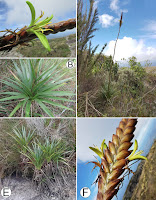 |
| Waltillia itambana T. Machado & Versieux, in Machado, Pivari & Versieux, 2021. |
Abstract
We describe Waltillia itambana, a new species placed in the previously monotypic genus Waltillia, presenting as main differences from Waltillia hatschbachii features such as a water-impounding rosette, shorter and broader leaves, divergent non-secund flowers and the light-green petals. The species is, as far as known, restricted to Pico do Itambé State Park, in Minas Gerais, growing above 1500 m of elevation in the rupestrian grasslands, of the Diamantina Plateau, Espinhaço Range, Minas Gerais State. We compare W. itambana with other similar species that occur in the rupestrian grasslands and provide illustrations, information on geographic distribution, a map, and ecological and conservation observations on the new species.
Keywords: endemism, lithophyte, mountain, neotropical, pollen, Vrieseinae, Monocots
Waltillia itambana T. Machado & Versieux, sp. nov.
Waltillia itambana is distinguished from W. hatschbachii by forming a water-impounding rosette (vs. non-impounding rosette), shorter leaf blade (up to 30 cm long vs. longer than 55 cm), leaf blade not canaliculate (vs. strongly canaliculate); longer inflorescence peduncle (ca. 174 cm long vs. 75–110 cm long), upper peduncle bracts ovate with obtuse apex (vs. narrowly lanceolate to ovate with Long-attenuate-acute apex), floral bracts completely covering the sepals (vs. equalling 3/5 to 5/6 of the length of the sepals), flowers suberect to divergent at anthesis, not secund (vs. distinctly downwardly secund at anthesis), and the internodes of the rachis shorter (1–1.2 cm long vs. 1–3.5 cm long).
Etymology:— The epithet “itambana” is a reference to the type locality, the Pico do Itambé region.
Distribution and ecology:— Waltillia itambana is restricted to Pico do Itambé State Park, in the state of Minas Gerais, Brazil. This state park encompasses one of the highest elevation areas in the Espinhaço mountain range and is situated at 61 km away from the type locality of W. hatschbachii, in the county of Gouveia, Diamantina plateau (Fig. 2). With this addition, the bromeliad flora of this State Park reaches now 12 genera and 17 species (Versieux 2008). The species described here is known from a single population with less than ten individuals observed, some occurring spatially aggregated, and exhibiting vegetative propagation with at least one axillary bud per rosette. W. itambana grows as a terrestrial on the thin layer of soil accumulated over the quartizite rock of the rupestrian grassland habitat. These plants occur at ca. 1590 m elevation, completely exposed to sunlight and close to small water streams.
Talita M. Machado, Marco Otávio D. Pivari and Leonardo M. Versieux. 2021. Expanding Waltillia: An Addition to A previously Monotypic Genus of Bromeliaceae from the Espinhaço Range, Brazil. Phytotaxa. 491(1); 1–11. DOI: 10.11646/phytotaxa.491.1.1






